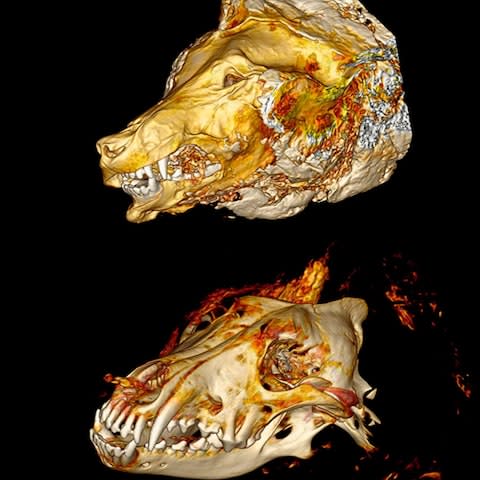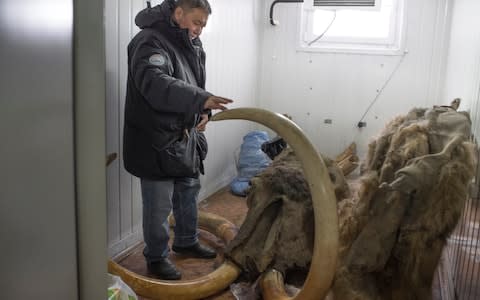40,000-year-old Ice Age wolf head found in Siberia

Russian and Japanese scientists have unveiled the first intact adult head of an Ice Age wolf species, which was preserved in permafrost for 40,000 years.
They hope that the unique find will help them learn more about an ancient predator that roamed Europe and Asia alongside the woolly rhinoceros and mammoth, including its ultimate fate.
"We want to answer the question of whether these wolves disappeared or turned into modern wolves, how much they are related to modern wolves," Albert Protopopov, head of mammoth fauna studies at the Yakutia academy of sciences, told The Telegraph.
Still covered in thick fur and sporting a vicious-looking set of fangs, the 40-centimetre head was made public at a woolly mammoth exhibition in Tokyo last week. The wolf was between two and four years old when it met its end.
The head was found on the Tirekhtyakh river by locals hunting for lucrative mammoth tusks in the remote Siberian region of Yakutia last year. Well-preserved infant cave lions have been previously discovered nearby.

The soil in most of Yakutia remains frozen year round, preventing ancient tusks and carcasses from decomposing. Specimens have been emerging ever more frequently as climate change gradually thaws this permafrost.
The mammoth tusk industry, which has been booming after China banned the carving of elephant ivory, has become the main source of palaeontological finds in the region, and the hunters gave the head to Mr Protopopov.
Unsure if it was thousands of years old or just a few hundred, he passed a sample to the museum of natural history in Stockholm, where the head was found to date to 40 millennia ago.
Researchers at the Jikei University School of Medicine in Tokyo performed tomographic scans to map muscles and tissue in the specimen.
Both the Stockholm and Tokyo facilities will continue to study the DNA and internal anatomy of the head, which includes a fully preserved brain. Working with Russian scientists, they plan to compare the animal's genetic makeup and morphology to the wolves of today.
It is not clear whether the “Pleistocene wolf” was larger than contemporary wolves, but its jaws were definitely stronger.
“They could kill bigger animals. Probably the biggest was a bison,” Mr Protopopov said.
“It's important for science because wolves in the the Pleistocene were broadly dispersed like cave lions,” he said. “There were lots of wolves but we don't know much about them.”

Several species of wolves lived during the Pleistocene ice age, including the celebrated dire wolf in the Americas. Based on bones found in Siberia, both dogs and modern wolves are believed to have split off from a wolf ancestor at least 27,000 years ago.
Siberian huskies carry some genes of this ancient wolf even today.
The Tokyo exhibition also featured a new Siberian cave lion cub specimen named Spartak, which weighs less than two pounds.
It is in near-pristine condition, like the wolf head, and will be compared to modern lions.
Scientists from Yakutia and Japan also hope to one day clone a woolly mammoth from tissue discovered in the Siberian permafrost, although such a project is not possible with current techniques.
Want the best of The Telegraph direct to your email and WhatsApp? Sign up to our free twice-daily Front Page newsletter and new audio briefings.


